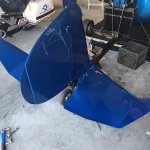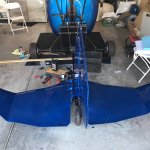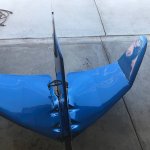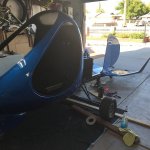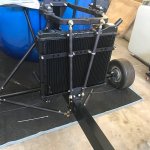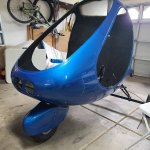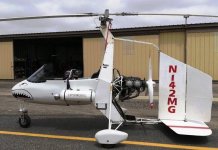I was searching the threads for any reference to the placement of the main gear in relation to the influence of the CG and the lift of the rotor during the take-off. I would think that a design which is too light or heavy one the nose in relation to the center of effort of the rotor would produce additional pilot load and challenges during departures. The transition between something which rolls to something which is flown should be as forgiving as design compromises allow. Where can one find data to advise the scratch builder vs the kit assembler on such matters?
I have not flown a gyroplane that I felt had the mains too far back in relation to the center of gravity so I don’t know what that feels like.
If the mains are what I feel is too far forward the nose comes up early and it is difficult to balance.
I flew one modified RAF where once the nose came off the ground I could not get it back down with the cyclic all the way forward. I had to stop and wait for the rotor to spool down to get it off the tail wheel.
Because of the low speeds when the nose tire leaves the ground it is difficult to control the direction of travel with the rudder and with a linked nose gear once the nose is off the ground directional control may be challenging.
I found making that transition from nose wheel control to rudder control difficult when the mains are too far forward.
I have a very light friend and client who very nearly ran off the runway several times before moving the main gear back.
He has a lot of diverse flying experience and is an airline transport pilot.
If you are going to design your own gyroplane I recommend you go to as many gyroplane events as practical and take pictures of every gyroplane you can find directly from the side and ask the owners how she flies.
I have found it impossible to tell where the center of gravity is without a double hang test.
In my opinion a gyroplane is not as simple as it looks and small changes in the center of gravity, the location of the rotor head and the location of the mains can make large differences in how she flies.
My recommendation is you purchase a known design, carefully refurbish it and get several hundred hours flying her and modifying her before designing and building your own.
An experienced gyroplane pilot can manage most design errors but they may be a trap for a low time, inexperienced gyroplane pilot.
The Predator is pretty easy to balance and steer with the rudder and typically lifts off around 45kts if the nose tire is kept near the ground.
Her center of gravity is typically about an inch above the thrust line and about half way between the fuel filler and the fuel sender (black thing on top of the tank ahead of the fuel filler) depending on fuel and passenger weight.
She flies pretty much at the angle she sits on the ground.

